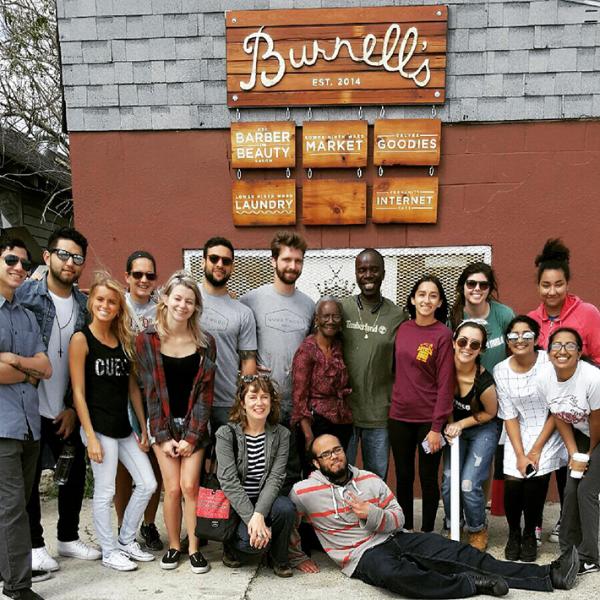Led by new faculty member Tippy Tippens of Goods that Matter, Loyola University New Orleans design students and GoodWood NOLA engaged in a three-week partnership to aid a local business. Burnell Cotlon’s Lower 9th Ward Market revealed a new business identity and signage created in partnership with Loyola University New Orleans design students and local design group GoodWood NOLA. A new brand, a new sign, a new logo, and neighborhood signage designed to increase community recognition of Cotlon’s four businesses was installed and revealed to the public on Wednesday, March 9, 2016. The reveal will mark an official renaming of the market that has grabbed local, national and international attention.
Currently, the Lower 9th Ward Market is the only source for fresh produce and groceries within a 3-mile radius of the neighborhood, decimated by floodwaters following Hurricane Katrina. Located in a 2-story plaza owned and renovated by Cotlon, it includes a market, a barbershop and café. Cotlon is in the process of adding on a laundry facility and an Internet café.
“I’m going to keep on going, keep on bringing more businesses that my community needs,” says Cotlon, 48, with contagious enthusiasm.
The neighborhood remains in dire need of help, Cotlon told NBC Nightly News anchor Lester Holt in August. With the help of volunteers, Ellen Degeneres, a gofundme account and others, he continues to pursue his dream of a flourishing business and a flourishing neighborhood.
“Currently, many Lower 9th Ward residents must take the bus and transfer three times in order to reach the local Wal-mart, the closest grocery store,” said Loyola design student Sierra Lyman. “Posting signage around the neighborhood will aid in awareness of the Lower 9th Ward Market ― and hopefully, decrease the amount of people taking that trip.”
The new Social Political Design + Narrative class at Loyola is based on the principles of experiential learning and designing for the social good. In line with the university’s social justice mission, the new design class brings students into the city to identify social needs and to work with community partners for social good. The course places a focus on “making the world a better place through design,” and is taught by new faculty member Tippy Tippens, named by GOOD magazine in 2013 one of 100 people pushing the world forward.”
When not teaching at Loyola, the acclaimed industrial and graphic designer is Chief Eternal Optimist of Goods that Matter, a New Orleans-based design for good studio and consulting company, where “eco-intelligence, creativity and innovative philanthropy unite…to advance social change.” Under her leadership, Loyola design students, GoodWood NOLA and Cotlon engaged in a three-week partnership. Collective aims were to let Cotlon’s community know more about the businesses offered in their neighborhood and to help establish the location as a cornerstone of the community.
Social Political Design + Narrative students chose to rename the plaza Burnell’s as an homage to Cotlon, who has owned the location since 2010.
GoodWood NOLA, a custom design and fabrication firm located in the Bywater area of New Orleans, provided design and building experience. Together with Tippens, the firm has helped Loyola design students to conceive, plan, design, create and install a plan that will help the local entrepreneur to change the community.
Loyola students came to the project with skills in hand lettering, textile design, design build, app design, and other skills taught in Loyola’s one-year-old Bachelor of Design degree program. Led by Design Department chair and professor of design Daniela Marx, it’s the only university design program in New Orleans.
Marx believes that students should learn traditional skills the New Orleans community wants and needs for its aesthetic to stand apart from that of other cities. At the same time, she’s training the artists of the 21st century.
“We’re embracing the old techniques―calligraphy and sign painting―that we know are so valued in this city, and we’re also teaching classes that embrace new technologies and tools needed to design for the future,” Marx said. “In social political design, students are collaborating with the community to identify communication needs and to develop creative design solutions.”


